 |
 |
 |
 |
Our objective was to set up a system for presenting information that would follow natural bodily movement. It was therefore important for visitors to be able to obtain information while moving through the presentation space without having to handle devices to do so. The information system that we have set up uses active RFID tags, thus allowing information to be presented without the need for any particular action.
In addition, the use of screens that go from being transparent to semi-transparent means that the displays are unobtrusive when there are no visitors in the room. The scenography thereby avoids the need for devices such as computer screens that may appear oppressive. When visitors draw near, the image is displayed and they can obtain information in a completely intuitive manner. |
 |
 |
 |
| Means of accessing information have been developed that dispense with any awareness of the presence of a system thanks to a device in the familiar form of a book combined with projected images. Image recognition technology allows users to access further information simply by turning the pages of a book. |
 |
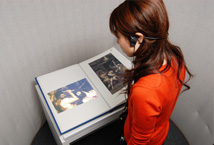 |
|
 |
 |
 |
| How does your gaze travel when you look at a work? In this presentation, an eye-tracking system makes it possible to follow your gaze and to measure the time spent looking at any particular part of the painting. The system then visually reconstructs the trajectory of your gaze on the work. The implementation of technology that allows contents to be activated by looking holds great potential in terms of accessibility. |
 |
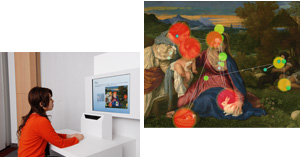 |
|
 |
 |
 |
| A space surrounded by three screens onto which images are projected plunges visitors into the work's core. This immersive device reconstructs the work's universe through three-dimensional synthetic images, allowing visitors a physical discovery of the work's composition and perspective. |
 |
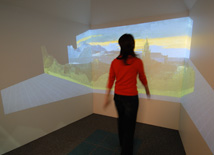 |
|
 |
 |
 |
 |
 |
| The PDA designed by the Louvre - DNP Museum Lab requires no "handling", leaving the visitor free to concentrate on discovering the artwork and its associated content. The audio commentaries are streamed automatically when the visitor approaches the various stations; they are broadcast using "bone phone" technology allowing visitors to listen to the commentaries and chat with their companions or the people around them at the same time. |
 |
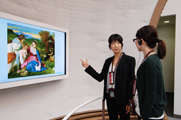 |
|
 |
 |
 |
| The server system streams commentaries simultaneously in three languages, identifying each visitor's choice of language (recorded at the Museum Lab reception desk) via their RFID tag. The progress of each visit is recorded on the RFID tag and transmitted to the server. Visitors can consult their data on the Museum Lab Web site, in the “My Museum Lab” members' zone. |
 |
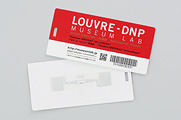 |
|
|
|

